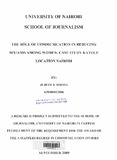Untitled
Abstract
This study presents findings of the survey conducted in Kayole, to gauge the extent to
which communication has contributed to reduction of HIV/AIDS prevalence within the
community. It presents views of Key Informants, members of Focus Group Discussions
and survey respondents, on the issues of communication in the community in relation to
HIV/AIDS.
This study contributes to the discussion about HIV/AIDS prevention efforts for one of the
so called high risk groups for HIV/AIDS in Kenya: women. It highlights some key social
and economic factors associated with HIV/AIDS. Data from respondents, key informant
and group discussions are analyzed using both qualitative and quantative procedures to
examine the nature of the relationship between communication and selected HIV/AIDS
variables.
The study sought to unearth barriers that stand in the way of communicating HIV/AIDS
messages. It aimed at establishing the correlation between communication and
HIV/AIDS. The study targeted all community members over 18 years to establish
communication and other factors that have made them adopt positive behavior. Latest
global survey says HIV and AIDS campaigners have failed to use effective
communication strategies to change behavior.
The study examined communication strategies that have been employed by various
stakeholders in the community to create awareness, the major factors that influence the
adoption of positive sexual behavior, and those that hinder. It also assessed the factors
that impinge the development of effective communication strategies for behavior change.
It focused on the interdependence of communication and health promotion campaigns
with particular reference to Kayole area, discussed in the context of other HIVIAIDS
strategies in Kenya.
Key findings reveal evidence of reduced prevalence of behavior that has led to the
reduced risk. The findings of this study indicate that significant strides have been made in
the HIVIAIDS national response. There has seen decline in the HIVIAIDS prevalence
rate from 14% in 2000 to 5.l % in 2006. The behavior change was significantly associated
with various communication strategies. The findings show Kenya has seen increased
scaling up of HIV and AIDS information campaigns, Voluntary Counseling and Testing
programmes (VCT), and improved access to Anti Retroviral Therapy (ART).
The findings indicate that behavior change in Kayole area was significant associated with
various communication strategies. Majority of residents attributed t
Description
Master of Arts Thesis

